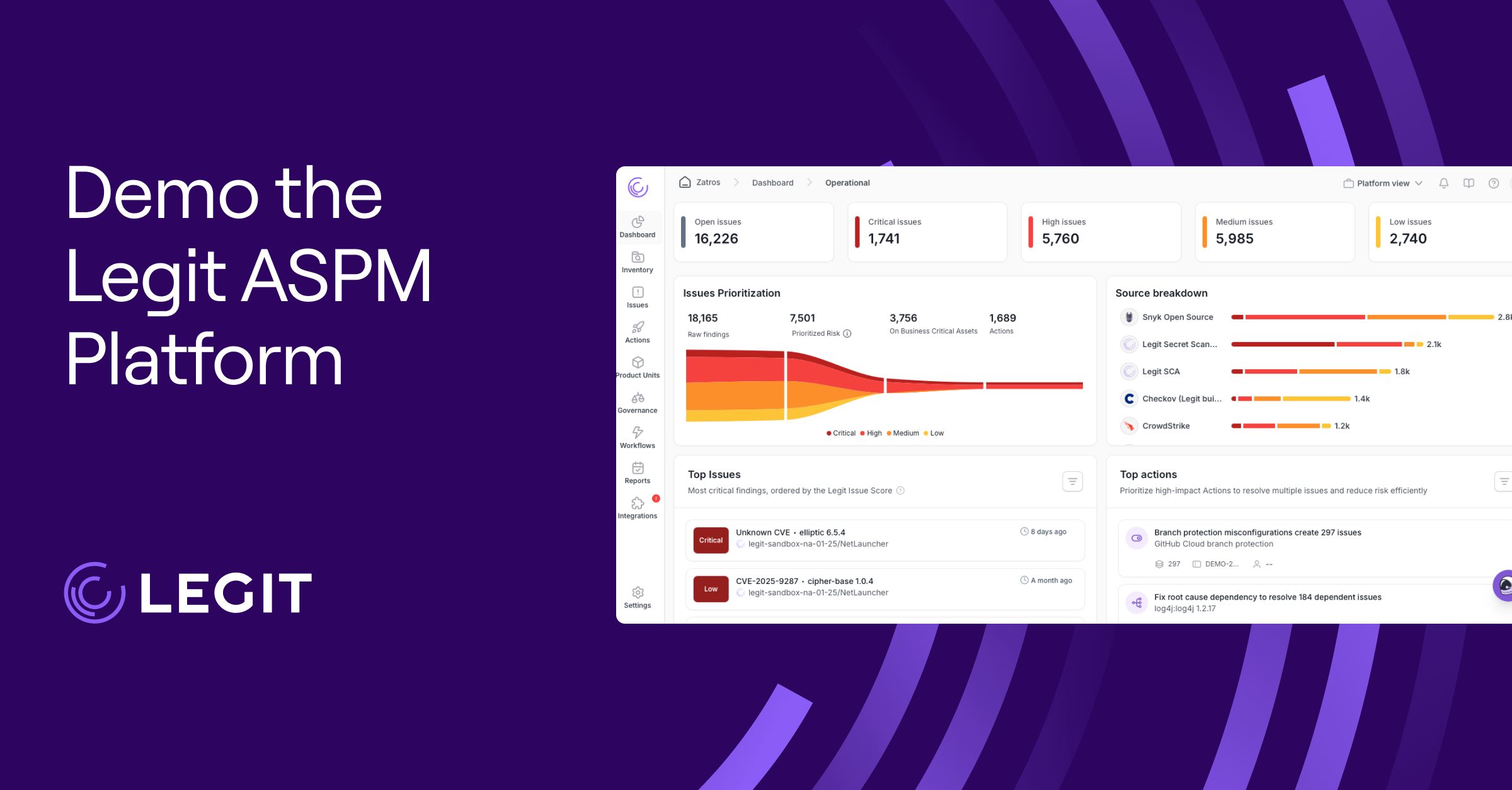In today’s world of software development, cybersecurity is more than a luxury; it's a necessity. Cyber threats aren’t only growing in frequency, complexity, and sophistication, they’re targeting developer environments and the software supply chain. The need for robust, secure software development frameworks is more critical than ever. However, not all organizations know how to secure their frameworks. Enter the Secure Software Development Framework (SSDF) from the National Institute of Standards and Technology (NIST).
The SSDF, a relative newcomer in the field of cybersecurity, is designed to guide organizations in developing secure software, all while safeguarding the software supply chain. Introduced in 2020, the SSDF offers an upgraded approach to the traditional software development lifecycle and was recently updated last year.
This article will delve into the key tenets of the SSDF, provide detailed insights into what they mean for developers and businesses, and offer practical tips for staying ahead of future NIST SSDF requirements. We will also look into how SSDF implementation can enhance the security of your code and help safeguard your business in today's ever-evolving cyber landscape. With security no longer being an afterthought, but a core component of software development, implementing the SSDF as part of your software development can make a major impact on your organization's resilience or vulnerability.
Breaking Down the Tenets of the SSDF
The Secure Software Development Framework (SSDF) represents a crucial shift in how organizations approach software development and supply chain security. The latest update to the National Institute of Standards and Technology (NIST) guidelines, was in response to Biden’s executive order to improve “the Nation’s Cybersecurity.”
Released in March of 2022, this recent update provides tighter controls aimed at safeguarding the software supply chain in an increasingly hostile digital environment. With the advent of the SSDF, the focus has significantly shifted towards a more robust and proactive approach to security, addressing the dire need for stronger measures to counteract the record-breaking number of hacks and attacks on businesses across various sectors while establishing secure software development standards to raise the floor of protection for organizations.
Despite its relative youth, the SSDF has rapidly gained traction as a comprehensive solution to the complex challenges that come with secure software development. Its inception reflects the ever-increasing demand for improved security measures and the necessity for businesses to prioritize the integrity of their software supply chains. Here’s a breakdown of the SSDF’s major tenets.
Prepare the Organization (PO)
The first tenet of the SSDF, is foundational to effectively implement the framework. It emphasizes the importance of preparing the development team as well as the entire organization for secure software development practices. This tenet recommends educating employees about NIST secure coding practices, designating key stakeholders, equipping them with the necessary skills, and establishing robust processes and systems to facilitate secure software development.
A major principle here is that the tenet shifts the responsibility of secure software development from being solely a developer's job to a shared organizational responsibility. This culture change enables software development with security integrated from the outset, reinforcing secure practices throughout.
Protect the Software (PS)
This tenet emphasizes the need to safeguard software from unauthorized access and malicious actors throughout the development process. As part of the NIST secure software development framework, the PS tenet encourages organizations to adopt measures such as rigorous access controls, data encryption, strong authentication protocols, as well as engaging in archiving and protecting software releases. This is a much more tactical tenet that offers specific guidance on secure software development practices and processes.
Produce Well-Secured Software (PW)
This tenet focuses on the importance of developing software with as few vulnerabilities as possible and is the most detailed tenet. It aligns closely with NIST secure coding standards and provides a set of best practices to prevent, detect, and eliminate security flaws. Adhering to this tenet means implementing a security-centric development process that involves regular code reviews, thorough testing, and continuous monitoring to identify and rectify security issues quickly and effectively.
Respond to Vulnerabilities (RV)
The last tenet offers a proactive, structured approach to identifying, managing, and remediating vulnerabilities. It incorporates vulnerability management best practices advocated by NIST, including proactive vulnerability scanning, timely patch management, and responsive incident management. This ensures that any remaining vulnerabilities or software risks are addressed and corrected promptly, thereby strengthening the resilience of the software and reducing the potential for successful cyber attacks.
For a more comprehensive breakdown of the SSDF and how it’s different from the SSDLC, another framework, check out our article here.
8 Tips to Stay Ahead of Future NIST SSDF Requirements
As the government and other regulatory bodies continue to focus on cybersecurity, specifically software supply chain security, it’s important for businesses to aim to exceed the current NIST software development standards to stay ahead of potential updates, requirements, regulations, and ensure their systems remain secure against evolving threats. Here are some tips to bolster your organization's software supply chain that can pay off in the long run.
1. Make Security Settings a Default
Being proactive rather than reactive is crucial in cybersecurity. So businesses should consider incorporating security protocols throughout their software development process as the SSDF guidance suggests and make security settings the default. This approach ranges from flagging external emails to having 2FA and other tech management policies in place, all under the umbrella of the secure software development framework. This shift can result in a more resilient system that mitigates vulnerabilities and reduces the likelihood and overall risk of successful cyberattacks.
2. Keep an Eye on Third-Party Security Protocols
Internal security measures, while vital, are just one piece of the security puzzle. Given interconnected digital landscape involved in software development, businesses must extend their oversight to third-party relationships, particularly those involved in the Software Bill of Materials (SBOM). Ensuring that these suppliers adhere to stringent security protocols is critical in maintaining a secure software supply chain. This practice aligns with the NIST software security requirements, emphasizing the need for a comprehensive security approach that goes beyond one's own organization.
3. Check for Malicious Code and Malware
The cybersecurity landscape has shifted considerably, with threats emerging from previously trusted sources like Github and GitLab. However, malicious actors are now targeting these applications and injecting malware and malicious code through newly discovered vulnerabilities and exposures. Some organizations may not even know that these environments can be a risk factor.
Adopting practices published by the NIST secure software development framework can help address these new threats. This can be done by carrying out comprehensive checks on all software installed on systems, regardless of source. This practice involves scanning for known malware signatures, using behavior-based detection methods, and ensuring regular updates to threat databases. It can also be helpful to use solutions designed to identify and check for potential vulnerabilities or malicious signatures specifically within these developer environments.
4. Perform Security Checks Throughout
Traditionally, security checks were limited to a single phase in the Software Development Life Cycle (SDLC). However, the increasing sophistication of cyber threats calls for a more comprehensive and continuous approach to security. Instead of isolated checks, security assessments should be conducted throughout the SDLC. From the design stage to post-deployment, each phase should encompass checks and balances to ensure adherence to secure coding standards NIST has published. This approach allows for early detection and mitigation of vulnerabilities, significantly enhancing the security posture of the software product.
5. Create Internal Security Policies
By outlining precise security protocols within work instructions, an organization can instill a security-first approach in its internal management, foster a stronger security-centric culture, and maintain a better alignment with the guidelines of NIST secure software development.
A comprehensive internal security policy can provide guidance on secure coding practices, access controls, data handling procedures, and incident response strategies. It’s a reference point that ensures all employees understand their role in maintaining security and the correct protocols to follow.
Without such policies, there's a risk that coding teams could inadvertently introduce vulnerabilities into the system, creating potential weak points for exploitation. A robust internal security policy, on the other hand, provides a roadmap for secure operations, reducing the likelihood of security oversights and fortifying the organization's overall defense against cyber threats.
6. Restrict Access & Secure Repos
Certain security principles remain timelessly valuable, regardless of how technology evolves. Among these is the Principle of Least Privilege (PoLP), which advises that individuals, programs, or systems should have the minimum levels of access necessary to perform their tasks. Implementing PoLP helps mitigate the risk of unauthorized access or data leaks by limiting the potential impact of a compromised account.
Alongside access control, securing data repositories is incredibly important to ensure data security and risk mitigation. This involves employing a range of techniques, from encryption and multifactor authentication to regular audits and security monitoring. Ensuring that repositories are secure protects the integrity and confidentiality of data, reducing the likelihood of data breaches or other security incidents.
Vulnerability management best practices as suggested by NIST can help you keep these repositories secure by increasing your visibility and awareness of potential exploits and vulnerabilities malicious actors can utilize to compromise your organization.
7. Develop an Escalation/Mitigation Plan
Despite your best efforts, guaranteeing absolute protection is impossible. Vulnerabilities can persist, attacks can occur, and breaches are more likely to happen than not. The need for a robust escalation and mitigation strategy, a crucial part of secure software development standards, can’t be overstated.
An escalation plan outlines the steps necessary when a potential threat, compromise, incident, or breach is detected. It specifies communication channels, key personnel, and the immediate actions required to mitigate the damage. A mitigation plan provides a roadmap for recovery, including procedures for patching vulnerabilities, preserving evidence, and learning from the incident to prevent future occurrences.
These plans can significantly reduce the time taken to respond to a threat, limit the damage inflicted, and enable swift recovery. It’s a vital component of a holistic approach to cybersecurity and necessary for any business that values the security and integrity of its software and data.
8. Don’t Leave Security Measures for Last
Cybersecurity has to be integrated throughout the SDLC, not merely treated as a final step or a box to tick. The principles of the NIST secure software development framework advocate for an early and consistent application of security best practices. This ensures that cybersecurity is an essential element in the software development process.
Adopt SSDF to Enhance Your Code Security Today
Efficient and productive software development is complex enough and organizations need support and guidance on ensuring their SDLC is done securely and is mindful of new vulnerabilities. The NIST Secure Software Development Framework (SSDF) is a relatively recent innovation in the field, born from the growing need for a comprehensive and security-oriented approach to software development. With a focus on proactive, rather than reactive, security, the SSDF helps organizations embed security practices throughout the development process.
Adhering to NIST secure coding standards and software development guidelines, such as implementing the Principle of Least Privilege, securing data repositories, and developing an escalation and mitigation plan, can significantly enhance an organization's cybersecurity posture. By adopting a culture of security, as recommended by the framework, businesses can more effectively integrate any new security practices and processes within their software development.
Opting for SSDF implementation provides a path to developing software that is both functional and secure. While implementation may seem daunting, following the framework allows organizations to plan out their strategy and organizations can lean on tools and solutions that adhere to the framework and allow organizations to adopt the SSDF. These tools detect vulnerabilities within the SDLC, alert developers to insecure practices, and can help optimize the SDLC process in a secure way.
Ready to learn more? Schedule a product demo or check out the Legit Security Platform.
Download our new whitepaper.


